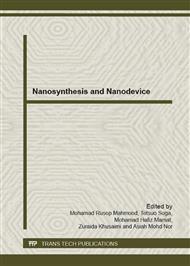[1]
F.M. Gray, Polymer Electrolytes, The Royal Society of Chemistry, UK, (1997).
Google Scholar
[2]
C.P. Fonseca, S. Neves, Characterization of polymer electrolytes based on poly(dimethyl siloxane-co-ethylene oxide, J. Power Sources 104 (2002) 85-89.
DOI: 10.1016/s0378-7753(01)00902-8
Google Scholar
[3]
S. Rajendran, O. Mahendran, R. Kannan, Lithium ion conduction in plasticized PMMA-PVdF polymer blend electrolytes, Materials Chemistry and Physics 74 (2002) 52-57.
DOI: 10.1016/s0254-0584(01)00400-x
Google Scholar
[4]
Y.W. Park, D.S. Lee, The fabrication and properties of solid polymer electrolytes based on PEO/PVP blends, J. Non-Crystalline Solids 351 (2005) 144-148.
DOI: 10.1016/j.jnoncrysol.2004.07.078
Google Scholar
[5]
F. Yuan, H.Z. Chen, H.Y. Yang, H.Y. Li, M. Wang, PAN-PEO solid polymer electrolytes with high ionic conductivity, Materials Chemistry and Physics 89 (2005) 390-394.
DOI: 10.1016/j.matchemphys.2004.09.032
Google Scholar
[6]
G.A. Nazri, S.G. Meibuhr, Effect of γ-radiation on the structure and ionic conductivity of 2-(-2-methoxy-ethoxy-ethoxy)polyphosphazane + LiCF3SO3, J. Electrochem. Soc. 136 (1989) 2450-2454.
DOI: 10.1149/1.2097423
Google Scholar
[7]
Z. Uchimoto, Z. Ogumi, F.R. Takehara, J.J. Foulkes, Ionically conductive thin polymer films prepared by plasma polymerization, Electrochem. Soc. 137 (1990) 35-40.
DOI: 10.1149/1.2086429
Google Scholar
[8]
N. Kobayashi, N. Kubo, R. Hirohashi, Control of ionic conductivity in solid polymer electrolyte by photo irradiation, Electrochim. Acta 37 (1992) 1515-1516.
DOI: 10.1016/0013-4686(92)80101-q
Google Scholar
[9]
M. Watanabe, A. Nishimoto, Effects of network structures and incorporated salt spesies on electrochemical properties of polyether-based polymer electrolytes, Solid State Ionics 79 (1995) 306-312.
DOI: 10.1016/0167-2738(95)00079-l
Google Scholar
[10]
L.M. Ding, Synthesis, characterization and ionic conductivity of solid polymer electrolytes based on modified alternating maleic anhydride copolymer with oligo (oxyethylene) side chains, Polymer 38(16) (1997) 4267-4273.
DOI: 10.1016/s0032-3861(96)00985-8
Google Scholar
[11]
L.M. Ding, J. Shi, C.Z. Yang, Ion-conducting polymers based on modified alternating maleic anhydride copolymer with oligo (oxyethylene) side chains, Synth. Met. 87 (1997) 157-163.
DOI: 10.1016/s0379-6779(97)03817-4
Google Scholar
[12]
J. E Weston, B.C.H. Steele, Effects of inert fillers on the mechanical and electrochemical properties of lithium salt-poly(ethylene oxide) polymer electrolytes, Solid State Ionics 7 (1987) 75-79.
DOI: 10.1016/0167-2738(82)90072-8
Google Scholar
[13]
S. Rajendran, T. Uma, Effect of ZrO2 on conductivity of PVC-LiBF4-DBP polymer electrolyte, Materials Letters 44 (2000) 208-214.
DOI: 10.1016/s0167-577x(00)00029-x
Google Scholar
[14]
B. Kumar, L.G. Scanlon, R.J. Spry, On the origin of conductivity enhancement in polymer-ceramic composite electrolytes, J. Power Sources 96 (2001) 337-342.
DOI: 10.1016/s0378-7753(00)00665-0
Google Scholar
[15]
P.A.R.D. Jayathilaka, M.A.K.L. Dissanayake, I. Albinson, B.E. Mellander, Effect of nano-porous Al2O3 on thermal, dielectric and transport properties of the (PEO)9LiTFSI polymer electrolyte system, Electrochim. Acta 47 (2002) 3257-3268.
DOI: 10.1016/s0013-4686(02)00243-8
Google Scholar
[16]
F. Croce, L. Persi, B. Scrosati, F. Serraino-Fiory, E. Plichta, M.A. Hendrickson, Role of ceramic fillers in enhancing the transport of composite polymer electrolytes, Electrochim. Acta 46 (2001) 2457-2461.
DOI: 10.1016/s0013-4686(01)00458-3
Google Scholar
[17]
Q. Li, H.Y. Sun, Y. Takeda, N. Imanishi, J. Yang, O. Yamamoto, Interface properties between a lithium metal electrode and a poly(ethylene oxide) based composite polymer electrolyte, J. Power Sources 94 (2001) 201-205.
DOI: 10.1016/s0378-7753(00)00587-5
Google Scholar
[18]
S.S. Sekhon, G.S. Sandhar, Effect of SiO2 on conductivity of PEO-AgSCN polymer electrolytes, European Polym. Journal 34 (1998) 435-438.
Google Scholar
[19]
G. G Kumar, P. Kim, A.R. Kim, K.S. Nahm, R.N. Elizabeth, Structural, thermal and ion transport studies of different particle size nanocomposite fillers incorporated PVdF-HFP hybrid membranes, Materials Chemistry and Physics 115 (2009) 40-46.
DOI: 10.1016/j.matchemphys.2008.11.023
Google Scholar
[20]
V. Aravindan, P. Vickraman, Lithium flouroalkylphosphate based novel composite polymer electrolytes (NCPE) incorporated with nanosized SiO2 filler, Materials Chemistry and Physics 115 (2009) 251-257.
DOI: 10.1016/j.matchemphys.2008.11.062
Google Scholar
[21]
Tan Winie, A.K. Arof, FTIR studies on interaction among components in hexanoyl chitosan-based polymer electrolytes, Spectrochim. Acta A 63 (2006) 677-684.
DOI: 10.1016/j.saa.2005.06.018
Google Scholar
[22]
F.H. Muhammad, R.H.Y. Subban, S.R. Majid, Tan Winie, A.K. Arof, Characterisation of Al2O3 doped hexanoyl chitosan-LiCF3SO3-EC polymer electrolytes, Materials Research Innovations 13(3) (2009) 249-251.
DOI: 10.1179/143307509x440433
Google Scholar
[23]
M.J. Rice, W.L. Roth, Ionic transport in super ionic conductors: a theoretical model, J. Solid State Chemistry 4 (1972) 294-310.
DOI: 10.1016/0022-4596(72)90121-1
Google Scholar
[24]
G.C. Psarras, E. Manolakaki, G.M. Tsangaris, Dielectric dispersion and ac conductivity in-Iron particles loaded-polymer composites, Composites: Part A 34 (2003) 1187-1198.
DOI: 10.1016/j.compositesa.2003.08.002
Google Scholar
[25]
R. Murugaraj, G. Govindaraj, D. George, Ac conductivity and its scaling behavior in lithium and sodium bismuthate glasses, Materials Letters 57 (2003) 1656-1661.
DOI: 10.1016/s0167-577x(02)01047-9
Google Scholar
[26]
R. Ondo-Ndong, G. Ferblantier, F. Pascal-Delannoy, A. Boyer, A. Foucaran, Electrical properties of zinc oxide sputtered thin films, Microelectronics J. 34 (2003) 1087-1092.
DOI: 10.1016/s0026-2692(03)00198-8
Google Scholar
[27]
F.H. Abd El-kader, W.H. Osman, K.H. Mahmoud, M.A.F. Basha, Dielectric investigations an ac conductivity of polyvinyl alcohol films doped with europium and terbium chloride, Physica B 403 (2008) 3473-3484.
DOI: 10.1016/j.physb.2008.05.009
Google Scholar
[28]
A.E. Bekheet, N.A. Hegab, Ac conductivity and dielectric properties of Ge20Se75In5 films, Vacuum 83 (2009) 391-396.
DOI: 10.1016/j.vacuum.2008.05.023
Google Scholar
[29]
L.M. Sharaf El. Deen, The ac conductivity studies for Cu2O-Bi2O3 glassy system, Materials Chemistry and Physics 65 (2000) 275-281.
DOI: 10.1016/s0254-0584(00)00244-3
Google Scholar


